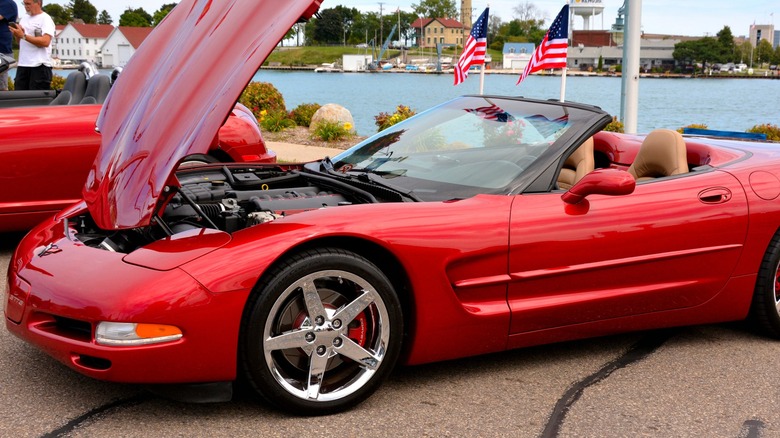GM's LS1 Vs. LS6 Engine: What's The Difference Between Them?
The popular small-block Chevy 350 has long been one of the most popular engine choices for General Motors automobiles. However, GM's venerable 350 cubic-inch V8 wasn't created overnight. Its roots go back to the mid-1950s when the first of a long line of small block V8s sharing similar architecture was created.
From its origin as the 265 cubic-inch (4.3-liter) Turbo-Fire, the small block Chevy V8 and later GM iterations have featured a common 4.4-inch spacing between cylinder bore centers, a single camshaft, pushrod-activated valvetrain, and two-valve-per-cylinder combustion chambers. This foundation set the stage for multiple generations of the small block Chevy V8, or SBC, platform, including the frequently-swapped LS1 engine.
Since its introduction in 1997, the LS1 has become a central piece of not just GM's legacy, but American car culture at large. Chevy has continued to evolve its powertrains in the years since, though, with the LS6 giving its older cousin a big boost in 2001. Here's how the two engines stack up against one another.
The LS1 laid the foundation for the LS6
The evolution of the SBC V8 continued with the release of the platform's third generation in 1997. With improved engine block and cylinder head casting methods, fuel delivery systems, and electronics, the newest SBC variant, the LS1, departed somewhat from its roots. However, it maintained the SBC's original 4.4-inch cylinder bore spacing, single camshaft, and pushrod valvetrain with two valves per cylinder.
Key characteristics of the Gen III LS1 include its 345.7 cubic-inch (5.7-liter) displacement derived from 3.89-inch (99.0 mm) cylinder bores over a 3.62-inch (92 mm) crankshaft stroke. The LS1 also benefitted from a new ignition system with individual coils near the spark plugs, replacing the old distributor system, and redesigned intake ports that increased engine airflow.
From 1997 to 2000, the LS1 produced 345 horsepower and 350 lb-ft of torque in C5 Corvettes. A modest improvement resulted in the 2001 to 2004 LS1 Corvettes' power increasing to 350 horsepower and 365 lb-ft of torque. In addition, F-body Camaros and Firebird Trans Ams got a slightly detuned LS1 with either 305 or 310 horsepower from 1998 until 2002.
How does the LS6 differ from the LS1?
The LS6 shares many similarities with the LS1, such as the same cylinder bore diameter, crankshaft stroke, displacement, and small block architecture. However, the LS6, purpose-built for the 2001 Chevrolet Corvette Z06, offers more performance. Compared to the LS1, the LS6 uses an air intake system with higher flow rates, stiffer valve springs capable of operating at higher rpm, and a camshaft with more lift and duration to open the valves farther and keep them open longer. In addition, the LS6 cylinder heads have slightly smaller combustion chambers that increase its compression ratio to 10.5:1 compared to the LS1's 10.1:1.
The 2001 Z06 LS6 produced 385 horsepower and 385 lb-ft of torque. However, the next LS6 iteration in 2002 increased those values to 405 horsepower and 400 lb-ft of torque thanks to increased exhaust flows, an even more aggressive camshaft, lighter valves, stronger valve springs, and smoother intake airflow. Though the more modern Corvette Z06s are still great (and expensive), the C5 generation holds a special place in Chevy history because of the LS6.


